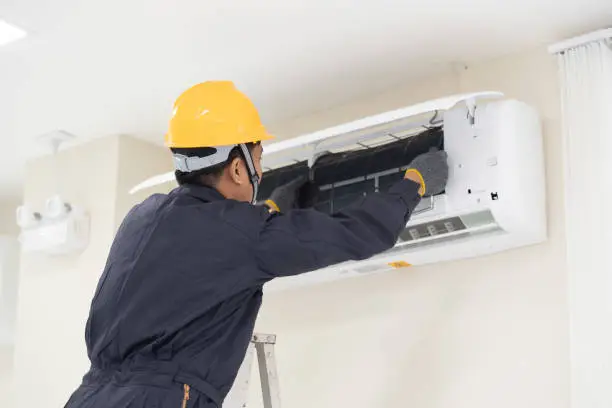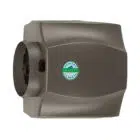
Table of Contents
As the summer months approach in Canada, the importance of a reliable air conditioning system becomes increasingly apparent. Air conditioning is not just about comfort; in many instances, it’s about creating a safe and productive environment. In this guide, we’ll delve into the workings of air conditioning systems, ensuring you gain a comprehensive understanding without being bogged down by overly technical details.
Basic Principle of Air Conditioners Work
Air conditioning systems cool indoor spaces through a process known as the refrigeration cycle, which involves four main components: the evaporator, compressor, condenser, and expansion valve. This cycle circulates a refrigerant that absorbs and releases heat, transitioning between gas and liquid states to cool the air.
In the evaporator, the refrigerant absorbs heat from the indoor air, causing it to evaporate and cool the air passing over the coils. The now vaporized refrigerant, carrying the absorbed heat, is compressed in the compressor, raising its temperature and pressure. This hot, pressurized vapor then moves to the condenser, where it releases the absorbed heat to the outside air and condenses back into a liquid. Finally, the refrigerant passes through the expansion valve, where its pressure and temperature drop before it returns to the evaporator to absorb heat again. This continuous cycle efficiently reduces indoor temperatures, providing a comfortable environment.
How the Air Conditioners Work: Step-by-Step
The refrigeration cycle is central to an air conditioners work, methodically moving refrigerant through a closed system to cool indoor air. Here’s a more detailed yet concise step-by-step breakdown of this cycle:
Evaporator Coil: Inside the air conditioner, the evaporator coil is where the cooling magic starts. The refrigerant inside the coil is initially cold and at a low pressure. When warm indoor air blows over the coil, the refrigerant absorbs the heat, causing it to evaporate. This phase change pulls heat from the air, cooling it before it’s circulated back into the room.
Compressor: From the evaporator, the now vaporized refrigerant, carrying absorbed heat, moves to the compressor. This component is key to the system’s pressure manipulation. By compressing the gas, the compressor increases the refrigerant’s pressure and temperature, preparing it for the heat release process.
Condenser Coil: The hot, pressurized refrigerant vapor then travels outdoors to the condenser coil. Here, the refrigerant releases its heat to the outside air, aided by a fan that blows over the coil. As the refrigerant loses heat, it condenses and turns back into a liquid form, albeit still under high pressure.
Expansion Valve: The liquid refrigerant’s next stop is the expansion valve. This component plays a crucial role in reducing the refrigerant’s pressure through a throttling process. As the pressure drops, so does the temperature of the refrigerant, cooling it down significantly and preparing it to absorb heat once again in the evaporator.
This cycle of evaporation, compression, condensation, and expansion, repeated continuously, allows the air conditioning system to maintain a cool and comfortable indoor environment, efficiently removing heat from inside your home or office and releasing it outside.
Types of Air Conditioners

Understanding the various types of air conditioners can help you choose the best option for your needs. Here’s a detailed look at the common types of air conditioning systems available:
Central Air Conditioner
This system is ideal for cooling large spaces and entire homes efficiently. It consists of a central unit that cools and dehumidifies air before distributing it through a network of ducts and vents. Central air conditioners are known for their efficiency, especially when cooling multiple rooms or maintaining a consistent indoor climate.
Window Air Conditioner
A compact and self-contained unit, a window air conditioner is perfect for cooling single rooms. It’s mounted in a window or through a wall and works by expelling warm air outside and blowing cool air into the room. It’s a popular choice for its simplicity and ease of installation.
Split Air Conditioner
Also known as a ductless mini-split, this system has two main components: an outdoor compressor/condenser and one or more indoor air-handling units. They are connected by a conduit housing the power cable, refrigerant tubing, and a condensate drain. Split air conditioners are versatile, energy-efficient, and provide individual temperature control for different rooms.
Portable Air Conditioner
As the name suggests, this type is mobile and can be moved from room to room. It’s a standalone unit that exhausts heat through a window or wall vent and is ideal for spaces where traditional air conditioners can’t be installed or for temporary cooling needs.
Hybrid/Dual Fuel Air Conditioner
This innovative system combines a heat pump with a gas furnace, optimizing energy use by switching between electricity and gas depending on the temperature. In warm months, it functions like a standard heat pump, absorbing heat from inside and releasing it outdoors. When it gets colder, the system uses natural gas, providing efficient heating while saving on electricity bills.
Geothermal Air Conditioning
Utilizing the stable temperatures underground, geothermal systems are among the most energy-efficient types of air conditioners. They use a series of pipes buried underground to exchange heat with the earth, providing cooling in the summer and heating in the winter. While the installation cost is higher, the long-term energy savings and environmental benefits are significant.
If you’re considering installing a new air conditioning system or upgrading your current one, reach out to HVAC Service Solutions. Our experts can guide you through the selection process, ensuring you get the best type of air conditioner tailored to your specific needs, ensuring comfort and efficiency for your space.
Maintenance Tips
Proper maintenance is crucial for the efficiency and longevity of your air conditioner. Here are some practical tips to keep your system running smoothly:
Regular Filter Cleaning/Replacement: One of the simplest yet most effective ways to maintain your air conditioner is by regularly cleaning or replacing its filters. This can significantly improve your system’s efficiency and indoor air quality.
Coil Cleaning: Over time, the evaporator and condenser coils can accumulate dirt, reducing the system’s ability to absorb and release heat. Check and clean these coils annually to maintain optimal performance.
Inspecting Drain Channels: Clogged drain channels prevent an air conditioner from reducing humidity effectively, potentially causing excess moisture that could affect your home’s interior. Ensure these channels are clear to allow for proper drainage.
Professional Check-Ups: Beyond DIY maintenance, schedule annual service appointments with a qualified technician. They can handle complex tasks like checking refrigerant levels, testing for leaks, and ensuring electrical connections are sound.
Remember, regular maintenance not only prolongs the life of your air conditioner but also enhances its efficiency and reliability. Don’t hesitate to reach out to HVAC Service Solutions for top-notch professional AC maintenance services, ensuring your system remains in optimal condition year-round.
When to Consult a Professional

While routine cleaning and minor troubleshooting can often be managed independently, certain air conditioner issues require professional expertise to ensure safety, efficiency, and system longevity. Understanding when to call in specialists can save you from future headaches and potentially costly repairs. Here’s a more detailed look at when to seek professional assistance:
Professional Installation
The initial setup of your air conditioning system is critical. A professional installation ensures that your unit is correctly sized for your space, properly connected, and meets all safety standards. Technicians can also offer valuable advice on optimal placement and operation settings. An expertly installed air conditioner operates more efficiently, experiences less wear and tear over time, and provides reliable comfort.
Regular Professional Maintenance
Even if your air conditioner appears to be running smoothly, hidden issues could compromise its efficiency and longevity. Professional maintenance services typically include a detailed inspection of the system, cleaning of essential components, refrigerant level checks, and identification of potential problem areas. Regular expert maintenance can prevent unexpected breakdowns, enhance system efficiency, and ensure your air conditioner’s longevity.
Signs of Trouble
Certain indicators warrant immediate professional attention:
- Ineffective Cooling: If your unit is running but not lowering the temperature as expected, there could be an issue with the refrigerant, thermostat, or internal components.
- Unusual Noises: Grinding, squealing, or other strange sounds can indicate mechanical problems that need prompt attention.
- Odd Smells: Musty odors could point to mold in the system, while a burning smell might signal an electrical issue.
- Spikes in Energy Bills: An unexplained increase in your energy costs could be due to an inefficient air conditioner that needs servicing.
Addressing these issues promptly with professional help can prevent minor concerns from escalating into major repairs, ensuring that your air conditioner remains a reliable source of comfort.
Find out how to troubleshoot the most common air conditioner problems in our previous article via the link below.
https://thehvacservice.ca/air-conditioner-troubleshooting-most-common-problems-solutions/
Conclusion
Understanding how your air conditioner works and recognizing the importance of regular maintenance and professional servicing are key to ensuring your system’s efficiency, longevity, and reliability. By staying informed and proactive, you can enjoy a comfortable and cool environment in your home or office.
For expert advice, installation, or maintenance services, don’t hesitate to reach out to HVAC Service Solutions. Our team is committed to providing you with the best HVAC solutions tailored to your needs, ensuring your air conditioning system operates at its best.
FAQs
What is the basic principle behind how air conditioners work?
The refrigeration cycle is the core principle behind air conditioning. This cycle involves a refrigerant that absorbs indoor heat and releases it outside. The cycle includes evaporation (where the refrigerant absorbs heat and cools the indoor air), compression (increasing the temperature and pressure of the refrigerant), condensation (releasing the absorbed heat outdoors), and expansion (lowering the refrigerant’s pressure and temperature to start the cycle anew). This continuous cycle maintains a cool and comfortable indoor environment.
What are the main components of an air conditioning system?
The main components include:
- Evaporator Coil: Absorbs heat from the indoor environment, cooling the air as the refrigerant evaporates.
- Compressor: Increases the pressure and temperature of the refrigerant vapor, preparing it for heat release.
- Condenser Coil: Facilitates heat release to the outdoor air, turning the refrigerant vapor back into a liquid.
- Expansion Valve: Reduces the refrigerant’s pressure and temperature before it re-enters the evaporator, ready to absorb heat again.
How often should I clean or replace the air filters in my air conditioner?
Cleaning or replacing air filters every 1-3 months is crucial for maintaining air quality and efficiency. Filters can become clogged with dust, reducing airflow and forcing the system to work harder, which can lead to increased energy costs and reduced lifespan of the unit.
What are the different types of air conditioners available?
In 2024, consumers have a variety of air conditioners to choose from:
- Central Air Conditioners: Best for cooling large spaces or multiple rooms, these are efficient but require ductwork.
- Window Air Conditioners: Ideal for single rooms or small spaces, they are affordable and easy to install.
- Portable Air Conditioners: Offer flexibility to move from room to room, suitable for spaces where window units are impractical.
- Split Air Conditioners: Comprise an outdoor and indoor unit, providing efficient cooling without ductwork, perfect for specific room cooling.
- Ductless Mini-Split Systems: Similar to split systems but allow for individual room control, enhancing energy efficiency and personalized comfort.
Why is professional installation important for air conditioners?
Professional installation is crucial because it ensures that your air conditioning system is correctly sized and properly installed, factors that are vital for optimal efficiency and performance. A professional installer will evaluate your home’s cooling needs, considering factors such as square footage, window placement, insulation, and even local climate to recommend the appropriate size and type of system. An oversized or undersized unit can lead to inefficient operation, increased energy costs, and premature system failure. Additionally, professional installers ensure that the system complies with all local and national building codes and safety standards, reducing the risk of electrical issues or refrigerant leaks, which can be hazardous.
How can I tell if my air conditioner needs professional service?
Signs that your air conditioner requires professional attention include inadequate cooling, uneven cooling across rooms, persistent unusual noises, and strange odors. For instance, a grinding sound could indicate a motor bearing problem, while a musty smell might suggest mold growth within the unit or ductwork. An unexplained increase in your energy bills can also signal that your system is working harder than it should, possibly due to a refrigerant leak or dirty coils affecting its efficiency. Addressing these signs quickly with a professional service can prevent minor issues from escalating into major repairs, extend the lifespan of your unit, and ensure it operates efficiently.
What maintenance tasks can I perform myself?
While professional maintenance is essential for complex system checks, there are several maintenance tasks you can perform to help keep your system running efficiently. Regularly cleaning or replacing air filters (every 1-3 months) can prevent airflow obstruction and maintain indoor air quality. Keeping the area around your outdoor unit clear of debris, such as leaves or dirt, ensures proper airflow and heat exchange. Checking the insulation on refrigerant lines and ensuring it’s intact can prevent energy loss. Additionally, maintaining a clean environment around the indoor unit and ensuring that the condensate drain is not blocked can help prevent water leaks and maintain optimal humidity levels.
What does professional AC maintenance include?
Professional AC maintenance involves a comprehensive check of the entire system to ensure all components are functioning correctly. This includes inspecting and cleaning the evaporator and condenser coils, which can lose efficiency when dirty. Technicians will also check refrigerant levels and look for leaks, which can be detrimental to efficiency and the environment. Electrical connections and controls will be tested to ensure safe and proper operation. The technician will also inspect the thermostat for accuracy, lubricate moving parts to reduce wear, and check the condensate drain for blockages. This thorough maintenance helps prevent unexpected failures, extends the lifespan of the unit, and ensures it runs as efficiently as possible.
Can an air conditioner also heat my home?
Yes, certain types of air conditioners, such as heat pumps and ductless mini-split systems, can provide both cooling and heating. These systems use a reversible refrigeration cycle that can switch between cooling and heating modes. During the winter, heat pumps extract heat from the outside air (even in cold temperatures) and transfer it indoors. This dual functionality makes heat pumps and ductless mini-splits versatile options for year-round climate control, offering an energy-efficient alternative to traditional heating systems.
How can HVAC Service Solutions help with my air conditioning needs?
HVAC Service Solutions is dedicated to providing comprehensive HVAC services, including expert installation, routine maintenance, and timely repairs. Our team ensures that your air conditioning system is perfectly tailored to your needs, professionally installed, and well-maintained for optimal performance and longevity. Whether you’re looking to install a new system, require preventive maintenance, or need urgent repairs, our skilled technicians are equipped to provide high-quality service. By choosing HVAC Service Solutions, you’re ensuring that your air conditioning system receives the care it needs to provide reliable and efficient cooling (and heating, if applicable) for your home.
Share



















